1. CARTESIAN PRODUCT OF SETS
Ordered pair
Let A and B are any two non-empty sets. If and then (a, b) is called and ordered pair. a is called the first component (first coordinate) and b is called the second component (second coordinate) of the ordered pair (a, b).
Cartesian product of sets
The Cartesian product (also known as the cross product) of two sets A and B, denoted by A´B (in the same order) is the set of all ordered pairs (x, y) such that x∈A and y∈B. What we mean by ordered pair is that the pair(a, b) is not the same the pair as (b, a) unless a = b. It implies that A⨯B ≠ B⨯A in general. Also if A contains m elements and B contains n elements then A⨯B contains m⨯n elements. Similarly we can define A⨯A = {(x, y); x∈A and y∈A}. We can also define cartesian product of more than two sets.
e.g. A1⨯ A2⨯A3 ⨯ . . . .⨯ An = {(a1, a2, . . . , an): a1 ∈ A1, a2 ∈ A2, . . . , an ∈ An}
Illustration -1
If A ={a, b, c} and B = {b, c, d} then evaluate
(i). A⋃B , A⋂B , A-B and B-A
(ii). A⨯B and B⨯A
Solution
(i) A⋃B = {x: x∈A or x∈B} = {a, b, c, d}
A⋂B = {x: x∈A and x∈B} = {b, c}
A-B = {x: x∈A and x∉B} = {a}
B-A = {x: x∈B and x∉B} = {d}
(ii) A⨯B = {(x, y): x∈A and y∈B} = {(a, b), (a, c), (a, d), (b, b), (b, c), (b, d), (c, b), (c, c), (c, d)}
B⨯A = {(x, y): x∈B and y∈A}
= {(b, a), (b, b), (b, c),(c, a), (c, b), (c, c),(d, a), (d, b), (d, c)}
Note that A⨯B ≠ B⨯A.
Properties of cartesian product
Theorem 1 : For any three sets A, B, C
(i) A × (B ⋃ C) =(A × B) ⋃ (A × C)
(ii) A × (B ⋂ C) =(A × B) ⋂ (A × C)
Theorem 2 : For any three sets A, B, C
A × (B – C) = (A × B) – (A × C)
Theorem 3 : If A and B are any two non-empty sets, then
A × B = B × A A = B
Theorem 4 : If A ⊆ B, then A × A ⊆ (A × B) ⋂ (B × A)
Theorem 5 : If A ⊆ B, then A × C ⊆ B × C for any set C.
Theorem 6 : If A ⊆ B and C ⊆ D, then A × C ⊆ B × D
Theorem 7 : For any sets A, B, C, D
(A × B) ⋂ (C × D) = (A ⋂ C) × (B ⋂ D)
Theorem 8 : For any three sets A, B, C
(i) A × (B‘ ⋃ C‘)’ = (A × B) ⋂ (A × C)
(ii) A × (B‘ ⋂ C‘)’ = (A × B) ⋃ (A × C)
Number of elements in the cartesian product of two finite sets
Illustration -2
If A = {1,2}, B = {a, b} then find A × B & B × A .
Solution
2. RELATION
Let A and B be two non-empty sets, then every subset of A × B defines a relation from A to B and every relation from A to B is a subset of A × B.
Let and (a, b) ∈ R. Then we say that a is related to b by the relation R and write it as aRb. If (a,b)∈R, we write it as aRb.
Example : Let A {1, 2, 3, 4, 5}, B = {1, 3}
We set a relation from A to B as: a R b iff . Then
R ={(1, 1), (1, 3), (2, 3), (3, 3)}A⨯B
Representation of relation
Roster Form
In this method of describing a relation, all the ordered pairs which satisfying the formula given in the relation are listed. Let’s understand this method by an example.
If A = {5, 2, 1} write the following relations of A × A in the Roster form.
a) B is the relation “is greater than”
b) C is the relation “is less than”
Given A = {5, 2, 1}
A × A = {(5, 5), (5, 2), (5, 1), (2, 2), (2, 5), (2, 1), (1,1), (1, 5), (1, 2)}
a) B is the relation is greater than.
∴ B = {(5, 2), (5, 1), (2, 1)}
b) C is the relation is less than
∴ C = {(1, 2), (1, 5), (2, 5)}
Set-Builder Form
In this method, the property connecting the first coordinate and the second co-ordinate of every ordered pair of the relation is stated. Let’s understand this method by an example.
If A = {6, 3, 1} write the following relations of A × A in the set-builder form.
a) B is the relation “is greater than”
b) C is the relation “is less than”
Given A = {6, 3, 1}
A × A = {(6, 6), (6, 3), (6, 1), (3, 3), (3, 6), (3, 1), (1, 1), (1, 6), (1, 3)}
a) B = {(6, 3), (3, 1), (6, 1)
= {(x, y) / (x, y) ∈ A × A, x > y}
b) C = {(1, 3), (3, 6), (1, 6)} = {(x, y)/(x, y) ∈ A × A, y > x}
Representation of Arrow Diagram and Tree Diagram
Arrow Diagram
Let the relation from X to Y be described as {(1, 2) (2, 5), (3, 5)}; then it can be represented in the form of arrow diagram as follows:
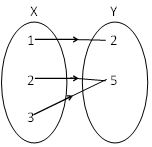
Tree diagram
If the relation between two sets is described as {(1, 4) (1, 5), (4, 3) (5, 7)} It can be represented in the form of tree diagram as shown in below.
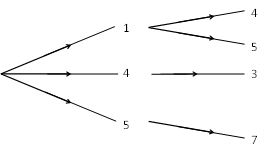
Graphical Representation of A × B
Let’s see this method of describing a relation by an example.
Let A = {1, 2, 3, 4} B = {2, 3, 4} be two sets.
Now, let’s represent A × B in a graph.
i) Draw two lines, one horizontal and other vertical, which are perpendicular to each other, denote 1, 2, 3…. on the horizontal and vertical lines.
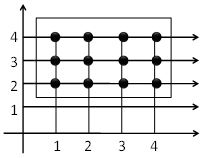
ii) Now, A × B = {(1, 2) (1, 3) (1, 4) (2, 2) (2, 3) (2, 4) (3, 2) (3, 3) (3, 4) (4, 2),(4, 3) (4, 4)}
iii) The intersecting point of the vertical line from point 1 and horizontal line from point 2 is denoted as (1, 2).
iv) Similarly, the intersecting point of the vertical line from point 1 and the horizontal line from point 3 is denoted as (1, 3).
v) The set of points so obtained is called the graph of A × B.
Number of relations
Let A and B be two non-empty finite sets consisting of m and n elements respectively. Then A × B consists of mn ordered pairs. So, total number of subset of A × B is 2mn. Since each subset of A × B defines relation from A to B, so total number of relations from A to B is 2mn. Among these 2mn relations the void relation f and the universal relation A × B are trivial relations from A to B.
Domain and range of a relation
Let R be a relation from a set A to a set B. Then the set of all first components or coordinates of the ordered pairs belonging to R is called the domain of R, while the set of all second components or coordinates of the ordered pairs in R is called the range of R.
Thus, Dom (R) = {a : (a, b) ∈ R} and Range (R) = {b : (a, b) ∈ R}.
Inverse relation
Let A, B be two sets and let R be a relation from a set A to a set B. Then the inverse of R, denoted by R–1, is a relation from B to A and is defined by
Clearly (a, b) ∈ R (b, a) ∈ R–1. Also, Dom (R) = Range and Range (R) = Dom
Example : Let A = {a, b, c}, B = {1, 2, 3} and R = {(a, 1), (a, 3), (b, 3), (c, 3)}.
Then, (i) R–1 = {(1, a), (3, a), (3, b), (3, c)}
(ii) Dom (R) = {a, b, c} = Range
(iii) Range (R) = {1, 3} = Dom
Illustration -3
Relation between the sets P and Q. Write this relation (i) in set-builder form, (ii) in roster form. What is its domain and range?
Solution
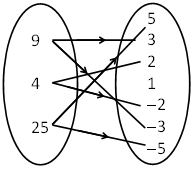
It is obvious that the relation R is “x is the square of y”.
(i) In set-builder form, R = {(x, y): x is the square of y, x ∈ P, y ∈ Q}
(ii) In roster form, R = {(9, 3), (9, –3), (4, 2), (4, –2), (25, 5), (25, –5)}
The domain of this relation is {4, 9, 25}.
The range of this relation is {– 2, 2, –3, 3, –5, 5}.
Note that the element 1 is not related to any element in set P.
The set Q is the codomain of this relation.
Note
| The total number of relations that can be defined from a set A to a set B is the number of possible subsets of A × B. If n(A ) = p and n(B) = q, then n (A × B) = pq and the total number of relations is 2pq. |
Illustration -4
Let A = {1, 2} and B = {3, 4}. Find the number of relations from A to B.
Solution
We have, A × B = {(1, 3), (1, 4), (2, 3), (2, 4)}.
Since n (A × B) = 4, the number of subsets of A×B is 24. Therefore, the number of relations from A into B will be 24.
Remark
A relation R from A to A is also stated as a relation on A.
Illustration -5
If R = {(2, 3), (2, 4), (3, 4), (4, 3), (3, 2), (4, 2)} Is a relation in A = {2, 3, 4}. Find R–1.
Solution
–1 = {(3, 2), (4, 2), (4, 3), (3, 4), (2, 3), (2, 4)}
Observe that R = R–1.
3. TYPES OF RELATIONS
1. Void relation
The relation having no ordered pairs is called a void relation and is denoted by
2. Universal relation
Let A be a set then
A×A is called universal relation on A
Note: The void and the universal relations on a set A are respectively the smallest and the largest relations on A.
Example : If A = {1, 2} then universal relation in A is A×A{(1,1),(1,2), (2,1), (2,2)}
3. Identity Relation
Let A be a set. Then the relation IA = {(a, a) : a ∈ A} on A is called the identity relation on A.
In other words, a relation IA on A is called the identity relation if every element of A is related to itself only. Every identity relation will be reflexive, symmetric and transitive.
Example : On the set = {1, 2, 3}, R = {(1, 1), (2, 2), (3, 3)} is the identity relation on A.
It is interesting to note that every identity relation is reflexive but every reflexive relation need not be an identity relation.
4. Reflexive relation
A relation R on a set A is said to be reflexive if every element of A is related to itself. Thus, R is reflexive (a, a) ∈ R for all a ∈ A.
Example : Let A = {1, 2, 3} and R = {(1, 1); (1, 3)}
Then R is not reflexive since 3∈A but (3, 3) ∉ R
A reflexive relation on A is not necessarily the identity relation on A.
The universal relation on a non-void set A is reflexive.
5. Symmetric relation
A relation R on a set A is said to be a symmetric relation iff (a, b) ∈ R (b, a) ∈ R for all a, b ∈ A
i.e., aRb bRa for all a, b ∈ A.
it should be noted that R is symmetric iff R–1 = R.
The identity and the universal relations on a non-void set are symmetric relations.
A reflexive relation on a set A is not necessarily symmetric.
Example : Let A = {1, 2, 3}, then R = {(1, 1), (1, 3), (3, 1)} is symmetric.
6. Anti-symmetric relation
Let A be any set. A relation R on set A is said to be an anti-symmetric relation iff (a, b) ∈ R and (b, a) ∈ R a = b for all a, b ∈ A.
Thus, if a ≠ b then a may be related to b or b may be related to a, but never both.
Example: Let N be the set of natural numbers. A relation R ⊆ N ⨯ N is defined by x R y iff x divides y (i.e. x/y)
Then x R y, y R x x divides y, y divides x x = y
7. Transitive relation
Let A be any set. A relation R on set A is said to be a transitive relation iff (a, b) ∈ R and (b, c) ∈ R (a, c) ∈ R for all a, b, c ∈ A i.e., aRb and bRc aRc for all a, b, c Î A. Transitivity fails only when there exists a, b, c such that a R b, b R c but a R c.
Example : Consider the set A = {1, 2, 3} and the relations
= {(1, 2),(1,3)}; = {(1, 2)}; = {(1, 1)};
= {(1, 2), (2, 1), (1, 1)}
Then are transitive while is not transitive since in but .
The identity and the universal relations on a non-void sets are transitive.
Note:
It is interesting to note that every identity relation is reflexive but every reflexive relation need not be an identity relation. Also identity relation is reflexive, symmetric and transitive.
8. Equivalence relation
A relation R on a set A is said to be an equivalence relation on A iff
(i) It is reflexive i.e. (a, a) ∈ R for all a ∈ A
(ii) It is symmetric i.e. (a, b) ∈ R (b, a) ∈ R, for all a, b ∈ A
(iii) It is transitive i.e. (a, b) ∈ R and (b, c) ∈ R (a, c) ∈ R for all a, b, c ∈ A.
Equivalence classes of an equivalence relation
Let R be equivalence relation in . Let a ∈ A. Then the equivalence class of a, denoted by [a] or is defined as the set of all those points of A which are related to a under the relation R. Thus [a] = {x ∈ A : x R a}.
It is easy to see that
(1)
(2)
(3) Two equivalence classes are either disjoint or identical.
Congruence modulo (m) :
Let m be an arbitrary but fixed integer. Two integers a and b are said to be congruence modulo m if is divisible by m and we write (mod m).
Thus (mod m) is divisible by m. For example, (mod 5) because 18 – 3 = 15 which is divisible by 5. Similarly, (mod 2) because 3 – 13 = –10 which is divisible by 2. But 25 ≠ 2 (mod 4) because 4 is not a divisor of 25 – 3 = 22.
The relation “Congruence modulo m” is an equivalence relation.
Composition of relations
Let R and S be two relations from sets A to B and B to C respectively. Then we can define a relation SoR from A to C such that (a, c) ∈ SoR b ∈ B such that (a, b) Î R and (b, c) ∈ S.
This relation is called the composition of R and S.
Example, if A = {1, 2, 3}, B = {a, b, c, d}, C={p, q, r, s} be three sets such that R = {(1, a), (2, b), (1, c), (2, d)} is a relation from A to B and S = {(a, s), (b, r), (c, r)} is a relation from B to C. Then SoR is a relation from A to C given by SoR = {(1, s) (2, r) (1, r)} In this case RoS does not exist.
In general RoS ≠ SoR. Also (SoR)–1 = R–1oS–1.
Illustration -6
A relation P in set Z of integers is given as P = {(a, b): (a + b) is a multiple of 5}. What kind of relation is P?
Solution
P is not reflexive as it is not necessary that a + a = 2a is a multiple of 5 for all a ∈ Z.
If (a, b) ∈ P, then a + b is a multiple of 5. Hence, b + a is also a multiple of 5.
(b, a) ∈ P
Thus, P is a symmetric relation.
Similarly, if (a, b) ∈ P and (b, c) ∈ P, then (a + b) and (b + c) are multiples of 5.
However, it is not necessary that (a + c) is also a multiple of 5.
Hence, (a, b) ∈ P and (b, c) ∈ P (a, c) ∉ P
Thus, P is not transitive.
Thus, P is a symmetric relation.
Illustration -7
Let T be the set of ages of all people of a locality with R, a relation in T, given by R = {(T1, T2) : T1 ≥ T2}. What kind of relation is R?
(A) Reflexive and symmetric
(B) Reflexive and transitive
(C) Symmetric and Transitive
(D) Equivalence relation
Solution
[B]
R is reflexive as the age of each member of the locality will be the same as the age of a particular person himself.
For (T1, T2) ∈ R ⇒ T1 ≥ T2 though it is not necessary that T2 ≤ T1.
Hence, the relation is not symmetric.
For (T1, T2) ∈ R and (T2, T3) ∈ R
T1 ≥ T2 and T2 ≥ T3
T1 ≥ T3
(T1, T3) ∈ R
Therefore, the relation is transitive.
Thus, relation R is reflexive and transitive..
Illustration -8
Consider a set A = {−2, −1, 3, 4}. Which of the following relations on A represents a trivial relation?
(A) R = {(a, b): ab is an even number, a, b ∈ A}
(B) R = {(a, b): ab is an odd number, a, b ∈ A}
(C) R = {(a, b): a + b ≥ − 3, a, b ∈ A}
(D) R = {(a, b): a − b ≥ − 6, a, b ∈ A}
Solution
[D]
A relation is called a trivial relation if it is an empty relation or a universal relation.
We have A = {− 2, − 1, 3, 4}.
If (a, b) ∈ R, then the minimum value of a − b will be −2 − 4 = −6.
In this case, a = − 2, b = 4
For all other ordered pairs (− 2, −1), (− 2, − 3), (− 2, − 2) etc. we will always have a + b ≥ − 6.
Hence, R = {(a, b): a − b ≥ − 6, a, b ∈ A} is a universal relation. Hence, it is a trivial relation.
Illustration -9
Relation R in the set H of human beings of a particular locality, defined as R = {(x, y): x is brother of y}, is a/an
(A) reflexive relation
(B) transitive relation
(C) symmetric relation
(D) equivalence relation
Solution
[B]
The given relation is R = {(x, y): x is brother of y}
The relation R is not reflexive as a human being x cannot be a brother of himself or herself.
If (x, y) ∈ R, then x is the brother of y.
It is not necessary that y is the brother of x because if y is a girl, then y cannot be the brother of x.
Therefore, (y, x) may or may not belong to R.
Therefore, R is not symmetric.
(x, y), (y, z) ∈ R
x is the brother of y and y is the brother of z
x is the brother of z
(x, z) ∈ R Thus, the given relation R is a transitive relation.
Illustration -10
Let P be the set of all triangles in a plane. A relation R in P is defined as
R = {(P1, P2): P1 is similar to P2} The relation R in the set P is a/an
(A) reflexive relation
(B) transitive relation
(C) symmetric relation
(D) equivalence relation
Solution
[B]
It is known that a relation R in a set X is said to be an equivalence relation, if R is reflexive, symmetric, and transitive.
The given relation is R = {(P1, P2): P1 is similar to P2}
The relation R is reflexive as every triangle is similar to itself.
If (P1, P2) ∈ R, then P1 is similar to P2.
P2 is similar to P1
(P2, P1) ∈ R
Therefore, R is symmetric.
(P1, P2), (P2, P3) ∈ R
P1 is similar to P2 and P2 is similar to P3
P1 is similar to P3 (P1, P3) ∈ R
Therefore, R is transitive. Thus, the given relation R is an equivalence relation.
Illustration -11
N is the set of natural numbers. The relation R is defined on N⨯N as follows:
(a, b) R (c, d) a + d = b + c
Prove that R is equivalence relation.
Solution
(i) (a, b) R (a, b) a + b = b + a
∴ R is reflexive.
(ii) (a, b) R (c, d) a + d = b + c
c + b = d + a
(c, d) R (a, b)
∴ R is symmetric.
Now (iii) (a, b) R (c, d) and (c, d) R (e, f) Þ a + d = b + c & c + f = d + e
a + d + c + f = b + c + d + e
a + f = b + e
(a, b) R (e, f)
∴ R is transitive. Thus R is an equivalence relation on N⨯N.
Illustration -12
A relation R on the set of complex numbers is defined by is real, show that R is an equivalence relation.
Solution
(i) is real
∴ R is reflexive
∴ is real.
(ii) is real is real
is real
∴ R is symmetric.
(iii) Let z1 = a1 + ib1, z2 = a2 + ib2 and z3 = a3 + ib3
where a1, b1, a2, b2, a3, b3 ∈ R
now is real
is real
(for purely real, imaginary part = 0
similarly, z2 R z3
z1 R z2 and z2 R z3
and
∴ R is transitive
Hence R is equivalence relation.
Illustration -13
Find all congruent solutions of 8x 6 (mod 14)
Solution
given 8x 6 (mod 14)
and here greatest common divisor of 8 and 14 is 2 so, there are two required solutions for = 3 and = 7, x = 6, 13
4. DEFINITION OF A FUNCTIONS
Definition 1
A function f is a relation from a non-empty set A to a non-empty set B such that domain of f is A and no two distinct ordered pairs in f have the same first element.
Definition 2
Let A and B be two non-empty sets, then a rule of which associates each element of A with a unique element of B is called a mapping or a function from A to B we write (read as f is a function from A to B).
For a function from A to B:
(i) A and B should be non-empty.
(ii) Each element of A should have image in B.
(iii) No element of A should have more than one images in B.
Illustration -13
Examine each of the following relations given below and state in each case, giving reasons whether it is a function or not?
(i) R = {(1, 2), (2, 2), (3, 1), (4, 2)}
(ii) R = {(2, 2), (1, 2), (1, 4), (4, 4)
(iii) R = {(1, 2), (2, 3), (4, 5), (5, 6), (6, 7)}
Solution
(i) Since first element of each ordered pair is different, therefore this relation is a function.
(ii) Since the same first element 1 corresponds to two different images 2 and 4, hence this relation is not a function.
(iii) Since first element of each ordered pair is different, therefore this relation is a function.
5. DOMAIN, CO-DOMAIN AND RANGE OF A FUNCTION
The set A is called as the domain of the map f and the set B is called as the co-domain. The set of the images of all the elements of A under the map f is called the range of f and is denoted by .
Thus, range of f i.e. .
Clearly
6. IMPORTANT FUNCTIONS AND THEIR GRAPHS
Polynomial functions: f(x) = a0 + a1x + a2x2 + ………+ anxn , where a0, a1, a2, ……, an ∈ R is said to be a polynomial function of degree n.
Identity function: An identity function in x is defined as f : R R, f(x) = x.
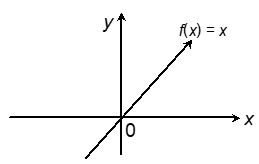
Absolute value function: An absolute value function in x is defined as f : R R, f(x) = |x|.
y = f(x) = | x | =
Domain : R ; Range : [0, ) ;
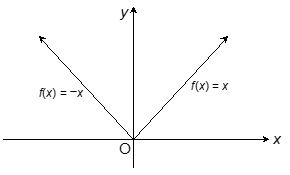
Greatest integer function (step function): The function f(x) = [x] is called the greatest integer function and is defined as follows:
[x] is the greatest integer less than or equal to x.
Then [x] = x if x is an integer
= integer just less than x if x is not an integer.
y = f(x) = [ x ] Domain : R ; Range : I
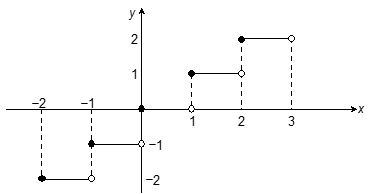
Signum function: The function is defined as
y = f(x) = sgn (x)
sgn (x) =
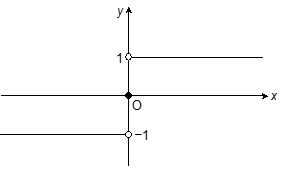
or sgn(x) =
Domain: R; Range {-1, 0, 1}
Rational algebraic function: A function of the form , where p(x) and q(x) are polynomials and q(x) ≠ 0, is called a rational function.
The domain of a rational function is the set of all real numbers except points where q(x) = 0.
Constant function: The function defined as f : R {c} where f(x) = c
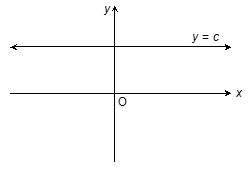
7. ALGEBRAIC OPERATIONS ON FUNCTIONS
Let us consider two functions.
f : D1 R and g : D2 R. We describe functions f + g, f – g, f.g and f/g as follows:
- f + g : D R is a function defined by
(f + g) x = f(x) + g(x), where D = D1 ⋂ D2
- f – g : D ® R is a function defined by
(f – g) x = f(x) – g(x), where D = D1 ⋂ D2
- f . g : D R is a function defined by
(f . g) x = f(x) . g(x), where D = D1 ⋂ D2
- f / g : D R is a function defined by
(f / g) x =, where D = D1 ⋂ {x ∈ D2 : g(x) ≠ 0}
- and is any real number.
Illustration-14
If is defined by is defined by , then find .
Solution:
is defined by
is defined by
is defined by
is defined by
is defined by
Illustration-15 Let be two functions defined over the set of non-negative real numbers. Find .
Solution:
Given ,
and








